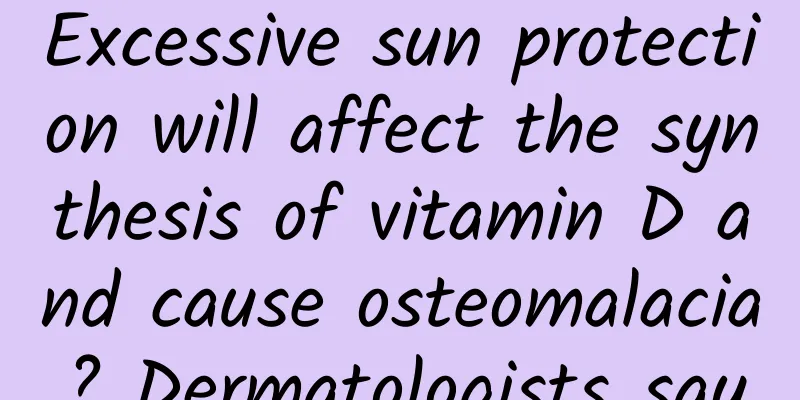Excessive sun protection will affect the synthesis of vitamin D and cause osteomalacia? Dermatologists say

|
Excessive sun protection can cause rickets! Recently, there has been news online that excessive sun protection will affect the synthesis of vitamin D, which in turn will lead to rickets. Rumor Analysis This statement is debatable. For ordinary people, excessive sun protection will not lead to vitamin D deficiency. In addition, even if extreme sun protection is really used, vitamin D can be supplemented orally, and there is no necessary causal relationship between it and osteomalacia. It can be said that sun protection has become an indispensable part of our modern lives. However, as sun protection awareness becomes more popular, concerns about sun protection also arise from time to time. Some people even worry that excessive sun protection may cause vitamin D deficiency or even rickets. Many people are confused about this. It is not good to protect against sunburn, and it is not good to not protect against sunburn. Should we protect against sunburn or not? Is excessive sun protection good or bad for health? Today, we will analyze this issue from the perspective of dermatologists. Will excessive sun protection cause rickets? People who ask this question are essentially concerned about whether there is a causal relationship between excessive sun protection and rickets, which is also called "bone softening" or "osteomalar disease" in medicine. The actual situation is more complicated, but if I have to give a simple answer, the reference answer is - there is a risk, but it is not big. In other words, there is a certain correlation between excessive sun protection and rickets, but the correlation is relatively weak, so there is no need to worry too much . The reason why there is a correlation is that excessive sun protection may lead to vitamin D deficiency, and vitamin D deficiency may lead to rickets. In addition, the reason why the correlation is weak is that: 1. There are many reasons for vitamin D deficiency. Excessive sun protection is not necessarily the decisive factor . Some people still suffer from vitamin D deficiency even if they have enough sun exposure. Therefore, other factors should also be taken into consideration, such as: living in an environment with less sunlight (less synthesis), lack of vitamin D in the diet (less intake), not taking additional vitamin D supplements (less intake), gastrointestinal diseases (less absorption), etc. 2. The cause of rickets is very complex. It may be a serious deficiency of vitamin D or an abnormality in vitamin D metabolism , such as the effects of drugs or internal diseases. If the vitamin D deficiency is not too severe (the 25-hydroxyvitamin D test result is above 25nmol/L), the risk of developing this disease is not high. 3. From the perspective of the population, rickets is a rare disease . Specifically, only about 2 people out of every 10,000 suffer from the disease. On the other hand, there are many people who protect themselves from the sun (including excessive sun protection), and the vast majority of people do not have this problem. If you do experience bone pain, frequent fractures, muscle weakness, difficulty walking, and your vitamin D level is consistently low (for example, below 25 nmol/L), you should suspect rickets and seek medical evaluation promptly. Copyrighted stock images, no reproduction is authorized Do you still need sunscreen? Although excessive sun protection may pose some health risks, sun protection itself is necessary. This is because the damage to the skin caused by ultraviolet rays in the sun is a foregone conclusion . Paying attention to sun protection is not an over-promotion by doctors, the media, or businesses, nor is it an advertisement, but is truly for the sake of everyone's health. It is also important to know that UV rays can have multiple health risks. For example: Short - term sun exposure can easily tan the skin, and the darker the skin, the easier it is to tan; if the ultraviolet rays are too strong, the skin can be sunburned , with patches of redness and burning pain. The lighter (whiter) the skin, the easier it is to sunburn. Not only that, in the long run, ultraviolet rays can make the skin age faster (we call it "photoaging"), which can manifest as sun spots, dull skin color, poor skin texture, deeper wrinkles, etc. In addition, it must be mentioned that long-term sun exposure will increase the risk of skin cancer , including basal cell carcinoma, squamous cell carcinoma and other cancers. It's easy to see, then, that sun protection is crucial to preventing these problems. Copyrighted stock images, no reproduction is authorized Overall, moderate sun protection can effectively protect the skin from UV damage, reduce tanning and sunburn, reduce the incidence of skin cancer, and delay skin aging. How to determine the degree of sun protection? As mentioned above, the main reason why people worry about excessive sun protection is that they are afraid of vitamin D deficiency. Here is a brief introduction. There are three key points to have proper vitamin D in the body: skin-assisted synthesis, dietary supplementation, and gastrointestinal absorption . All three are very important. In fact, many people do not have enough vitamin D in their bodies, even without strict sun protection. In addition, if you are in a place or season with less sunlight, or if you have darker skin, you are more likely to be deficient in vitamin D. If vitamin D deficiency is not serious (the test result of 25-hydroxyvitamin D is above 25nmol/L), the problem is not too big. Of course, it is still recommended that everyone pay attention to a healthy and balanced diet on a daily basis, and add more foods rich in vitamin D to the diet, such as fish, egg yolks, milk , etc., and even regular vitamin D drops can be used for supplementation. At the same time, you should also pay attention to your internal health, because some diseases (such as inflammatory bowel disease and celiac disease) can hinder the absorption of vitamin D. To be more cautious, you may wish to have regular physical examinations to monitor the level of vitamin D in your body, which is also an effective way to deal with vitamin D deficiency. Another thing to do is to find the right degree of sun protection . The right degree of sun protection means protecting the skin from UV damage while not hindering the synthesis of vitamin D in the body. That is, to find a balance between sun protection and vitamin D synthesis. So how do we find this balance? This requires us to flexibly adjust according to the actual situation such as the intensity of sunlight. For example, during the midday period when UV intensity is higher (mainly from 10 a.m. to 4 p.m. ), use a sunscreen with a high SPF value. Generally, SPF 30 or above can cope with most situations. For example, in the morning or evening when ultraviolet rays are weaker, you can reduce sun protection measures appropriately to allow your skin to be exposed to an appropriate amount of soft sunlight. Another tip is to pay attention to weather forecast software or the WeChat applet of the UV index, and pay attention to the changes in the UV index in your area, so as to accurately guide your daily sun protection measures. Here is a popular science, the UV index is an international measurement standard for the intensity of solar ultraviolet radiation at a certain location on a certain day, mainly used for daily forecasts, and is aimed at the general public. Our country has formulated different UV indices and corresponding protection recommendations, see the table below. UV index and protection recommendations In short, excessive sun protection may indeed have adverse effects on health, but this does not mean that we should give up sun protection. The key to the problem is to find a balance that can effectively protect the skin while reducing the risk of vitamin D deficiency. Therefore, by reasonably adjusting sun protection measures and combining a healthy lifestyle, we can maintain the health of our skin and bones while enjoying the sun. Looking in the mirror of rumors The causes of a disease are often complex, and some rumors tend to generalize and emphasize a single influencing factor, so we must be careful to distinguish them. Author | Tang Jiaoqing, attending physician of dermatology, doctor of medicine, popular science author Review | Feng Jun, deputy chief physician of the Dermatology Department of Sinopharm Tongmei General Hospital |
<<: How many steps are there to trim an elephant's feet?
Recommend
Case | How to use SEM to acquire customers stably and at low cost after the market is saturated?
With the market saturation, the decrease in incre...
360 Mini Programs are designed for all scenarios, breaking the boundaries between PC and mobile terminals.
On July 5, 2019, the 360 Mini Program public be...
In 2 minutes, you can learn about all advertising resources in iQiyi’s information flow!
The latest data from iResearch MUT in April shows...
Mr. San·Oral Copywriting Methodology-Advanced Topic Selection-Hot Copywriting, Improve the 5-second broadcast and quickly write hot copywriting
Mr. San·Oral Copywriting Methodology-Advanced Top...
Live streaming by celebrities is creating the Internet celebrity dream factory in the entertainment era, which is beginning to take shape
Recently, the 2016 Chinese Internet celebrity ran...
Image of lipstick: What is keyword density? Is SEO optimization affected by its density?
Many friends who don’t understand SEO don’t know ...
How does Pinduoduo achieve user growth?
Recently, Pinduoduo has been caught up in a count...
Even Durex can't save you! How to create copywriting that satisfies customers!
It is difficult for us to find a way to satisfy an...
The stainless steel kettle at home always has black stuff on it, what's going on? Is it poisonous?
I don’t know if you have ever encountered this si...
Are you feeling overwhelmed by life? These 4 methods will help you get back to your normal state!
...
Where does astronauts get water outside the earth?
There are three urine collection buckets in front...
Where might carcinogens be hidden in our lives?
Dangerous carcinogens are hidden everywhere in ou...
CCTV investigates mobile app youth mode: it is useless and the total time spent online cannot be controlled
[[360454]] While the online short video industry ...
Apple wants to make the iPad your primary work device
For a long time, people seemed to have not found ...
Discover the value of ACG creation. Who will be the ACG IP incubator?
The copyright dispute of "Legend of Miyue&qu...









